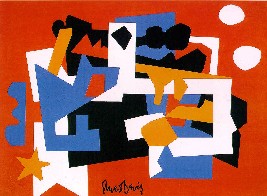"The essential elements of our poetry will be courage, daring, and
revolt."
--F.T. Marinetti
Randall Jerry, A Note on Poetry
(1946), includes the following elements:
- "[v]ery interesting language, a great emphasis on connotation,
- "texture"; extreme intensity,
- forced emotion--violence;
- a good deal of obscurity on sensation, perceptual nuances;
- emphasis on details, on the part rather than on the whole;
- experimental or novel qualities of some sort;
- a tendency toward external formlessness…:
- an extremely personal style--refine your singularities;
- lack of restraint--all tendencies are forced to their limits;
- there is a good deal of emphasis on the unconscious, dream structure,
the thoroughly subjective;
- the poet's attitudes are usually anti-scientific, anti-common-sense,
anti-public--he is, essentially, removed;
- poetry is primarily lyric, intensive--the few long poems are
aggregations of lyric details;
- poems usually have, not a logical, but the more or less associational
structure of dramatic monologue."
The Imagists defined their
movement this way:
- Direct treatment of the "thing", whether subjective or
objective.
- To use absolutely no word that does not contribute to the
presentation.
- As regarding rhythm: to compose in sequence of the musical phrase,
not in sequence of the metronome.
while T.S. Eliot in The Sacred
Wood understood modern poetry to have a kind of objectivism:
"The only way of expressing emotion in the form of art is by
finding an 'objective correlative'; in other words, a set of objects, a situation, a chain
of events which shall be the formula of that particular emotion; such as when
external facts, which must terminate in sensory experience, are given, the motion is
immediately evoked."
Joseph Frank in
"Spatial Form in Modern Literature" stresses the following non-narrative quality
to modern poetry:
"If the chief value
of an image was its capacity to present an intellectual and emotional complex
simultaneously, linking images in a sequence would clearly destroy most of their efficacy.
Or was the poem itself one vast image, whose individual components were to be apprehended
as a unity? But then it would be necessary to undermine the inherent consecutiveness of
language, frustrating the reader's normal expectation of a sequence and forcing him to
perceive the elements of the poem as juxtaposed in space rather than unrolling in
time."
In addition, one can include some of
the following:
- a distrust of the Romantic, uncomplicated, unified self
- a stress on the immediacy of image and symbol; the
"surface" of the poem matters most
- an attempt to picture a fragmented world with some resolution or
explanation via aesthetic form
- a stress on the college as a mediating form for the long poem
[also see http://en.wikipedia.org/wiki/Modernist_poetry_in_English
for a discussion of Modern Poetry in English.] |
